At Remitly, we love delving into the culture of different countries around the world. In this series, we’re celebrating the national dishes of the countries of some of our global customers. This time, we’re heading to Peru. Peru is located on the west coast of South America and shares borders with Ecuador, Colombia, Brazil, Bolivia and Chile. Its capital, Lima, sits at sea level, overlooking the Pacific Ocean. The varied geography and climate, coupled with the South American country’s extensive cultural history and influences from Europe, Asia and Africa, have resulted in rich and diverse culinary traditions.
Let’s take a look at some of the most typical Peruvian dishes.
Ceviche
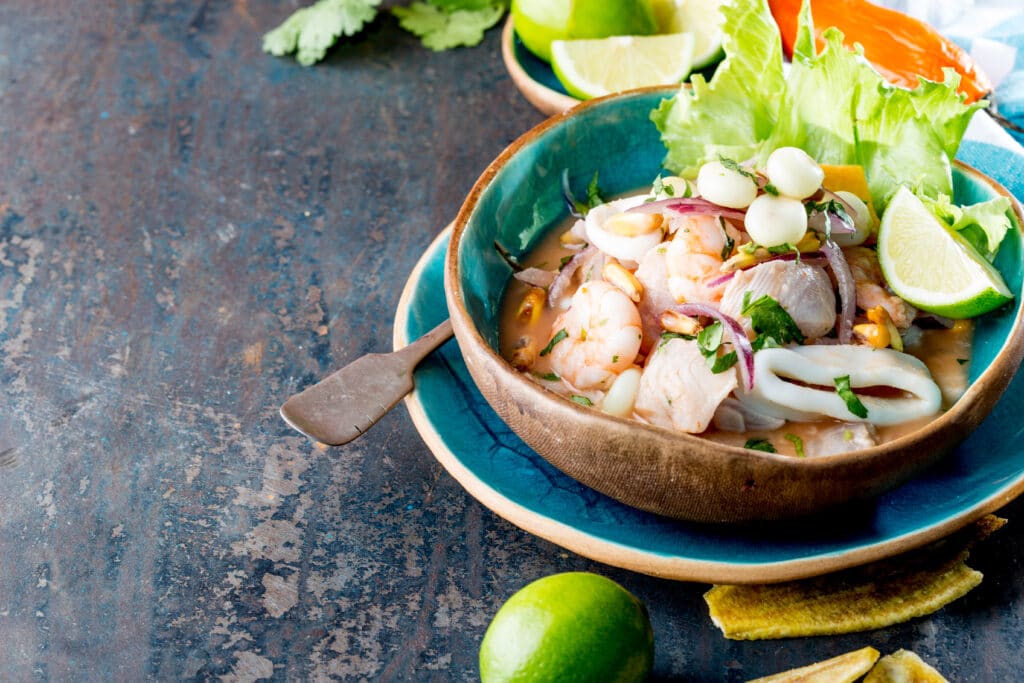
Ceviche is famed as one of Peru’s most treasured national dishes. The origin of the name is uncertain, and there are differing theories that it could come from Arabic, Quechua or Spanish. The dish itself has indigenous roots, and already existed when the Spanish arrived in Peru in the 16th century. They brought citrus fruits with them, which then became an integral part of the dish.
Fresh, raw fish is the key ingredient. The most traditional choice is sea bass (corvina), but other firm, white fish are also used. The fish sits in a marinade of lime juice, ají or chili peppers, red onions, cilantro and salt. The acidity of the juice “cooks” the fish, denaturing the proteins and turning it opaque.
Ceviche is often served with sweet potato (camote), corn (choclo) and toasted corn kernels (cancha) on the side. Peruvians commonly drink the leftover marinade, known as leche de tigre (“tiger’s milk”).
Lomo Saltado
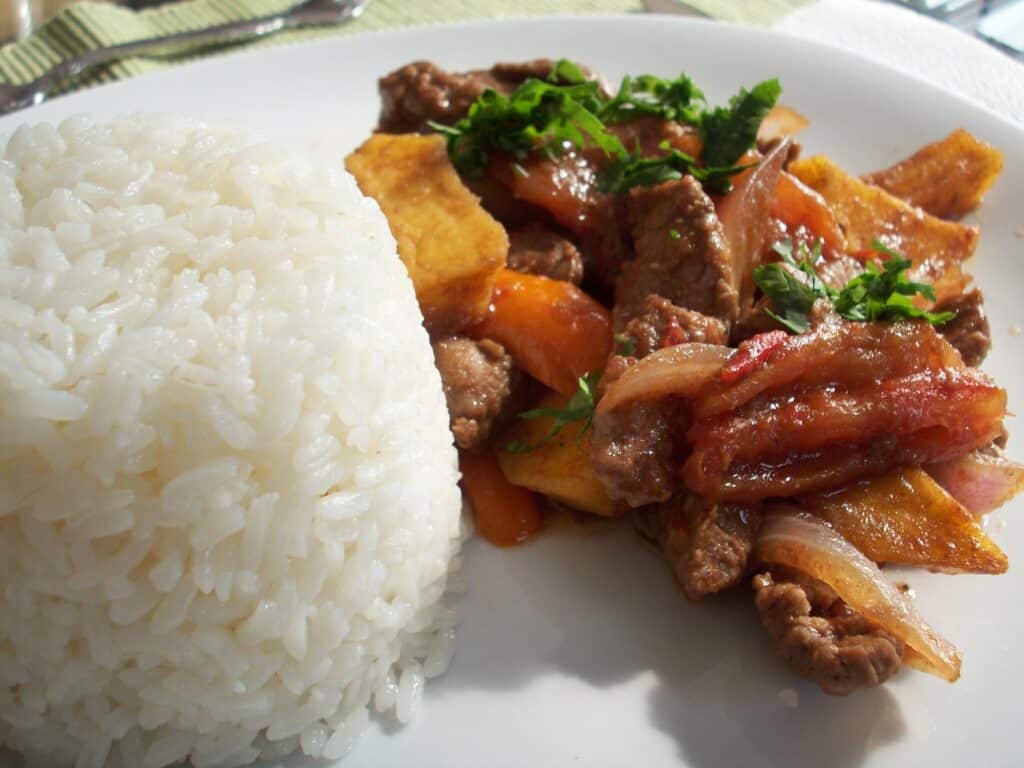
Lomo saltado is another beloved dish in Peruvian cuisine. It’s a common example of chifa cuisine, a fusion of Peruvian and Chinese cooking that reflects the influence of Chinese immigrants in Peru.
Lomo is the Spanish word for “loin,” referring to the cut of meat typically used in the dish. Saltado comes from the Spanish verb saltar, meaning “to jump” or “to leap.” In cooking, it refers to the cooking technique of stir-frying, where ingredients are cooked quickly on a very high heat and are moved around continuously to maintain their flavor and texture.
Strips of beef are marinated in a mix of soy sauce, garlic, vinegar and other seasonings that may include cumin. The beef is then stir-fried with red onions, tomatoes, ají amarillo, and sometimes bell peppers. French fries and white rice commonly accompany the dish, which is usually garnished with cilantro.
Ají de Gallina
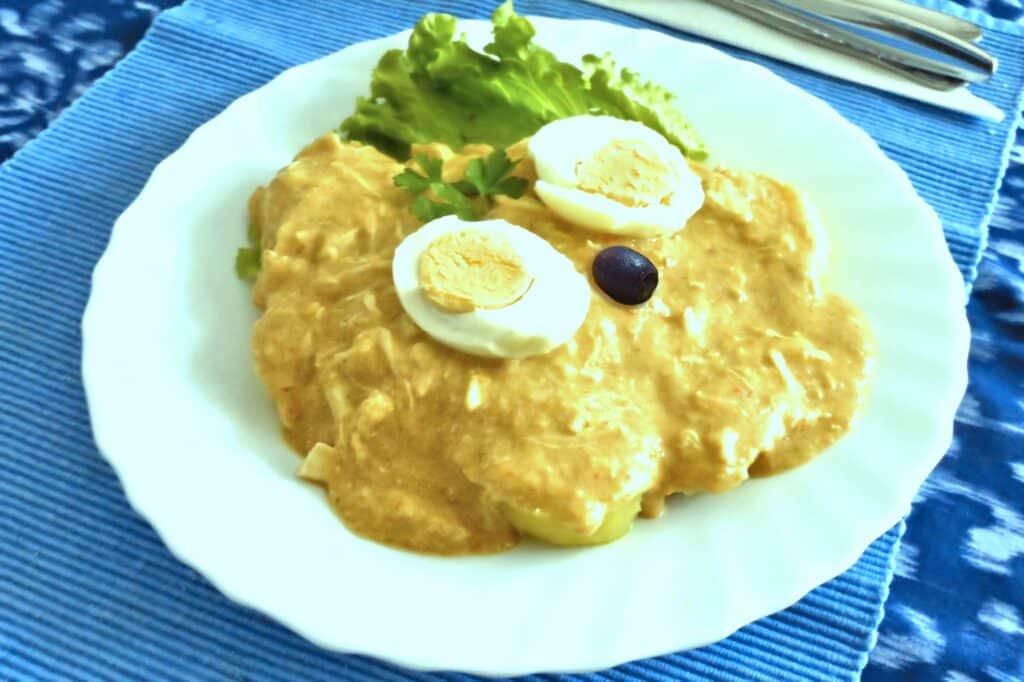
The name of this traditional dish refers to the main ingredients: Ají is the Spanish word for “chili pepper” and gallina is the Spanish word for “hen.” The dish itself has roots in Spain, but it has evolved over the years to incorporate Peruvian ingredients.
The base of the dish is poached and shredded chicken in a spicy, creamy sauce. The thickness and creaminess comes from bread that’s soaked in milk and then blended with the ají amarillo. Hard cheese, such as Parmesan, ground walnuts and seasonings are also added. Black olives and hard-boiled eggs are typical garnishes, along with boiled yellow potatoes and white rice.
Papa a la Huancaína
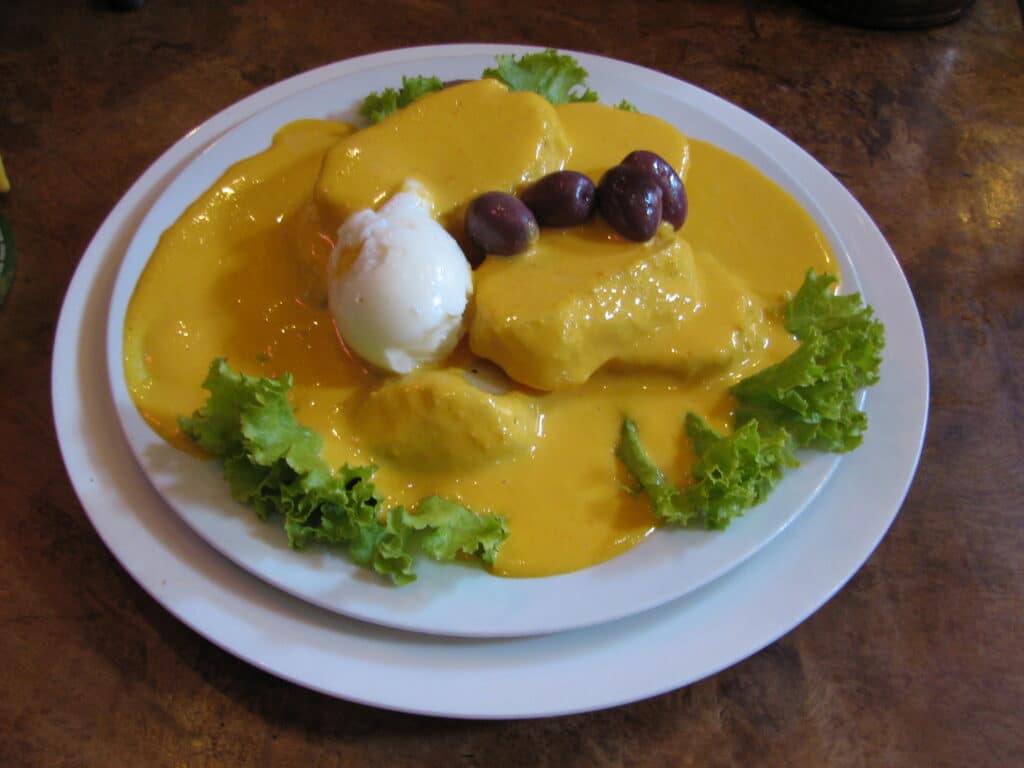
Papa a la Huancaína is a popular appetizer or side dish originating from Peru’s Andean region. Papa is the word for “potato” in much of Latin America, and a la Huancaína refers to the fact that the dish is in the style of Huancayo, a city in the Andes.
Ají amarillo, queso fresco, garlic, onion and milk or cream form a creamy and spicy sauce that’s usually served cold over boiled, sliced yellow potatoes. The dish is not to be confused with ocopa, another sliced potato dish with a sauce that contains peanuts, huacatay (a Peruvian herb, similar to mint) and cheese.
Anticuchos
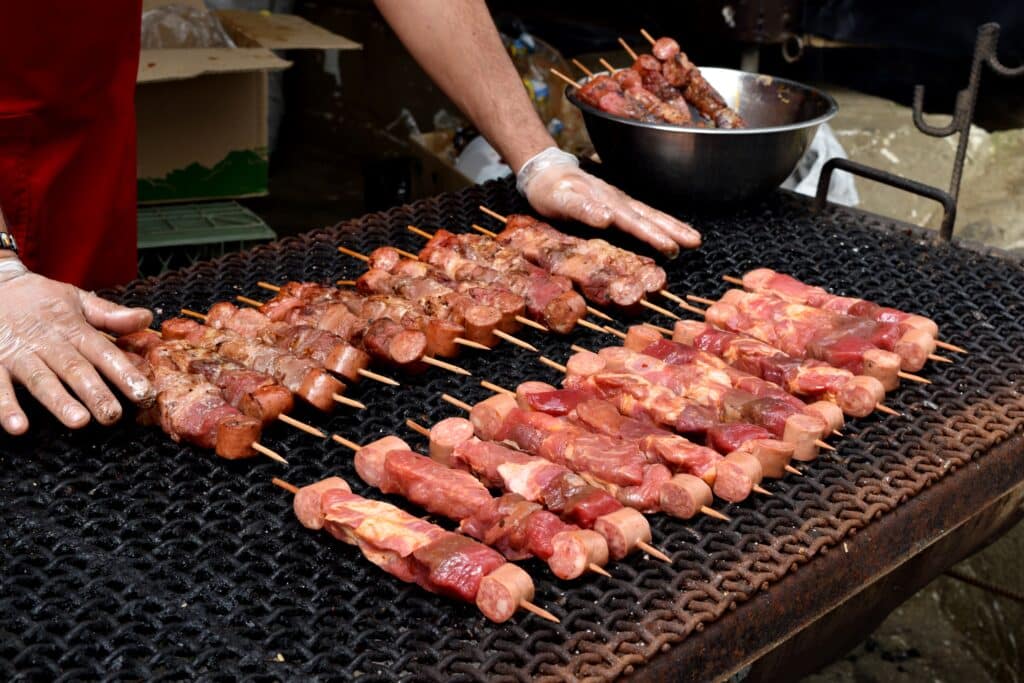
The most traditional version of anticuchos uses beef heart, but other meats are also used. The meat is marinated in ají panca (a smoky and earthy dried chili pepper), vinegar, garlic, cumin and seasoning. It’s then skewered and grilled, before being served with boiled potatoes, corn and sauces like salsa criolla or spicy ají sauces.
The name anticuchos comes from Quechuan. Anti means “east” or “the Andes” and k’uchu means “cut.” Skewered and grilled meat has been prepared and eaten in Peru for centuries.
Pisco Sour
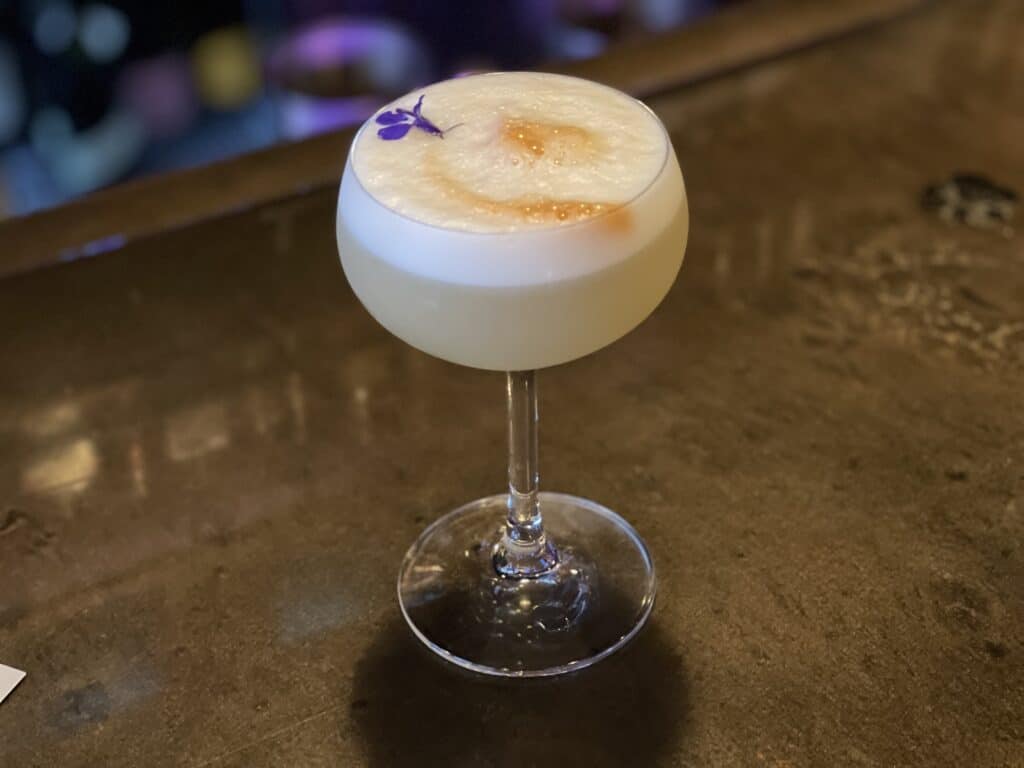
The pisco sour is probably the best-known of all Peruvian drinks. Pisco is the name of the type of brandy that forms the base of the cocktail, and its acidity comes from lime juice. Egg white, sugar syrup and bitter are the remaining ingredients.
Although it’s a classic Peruvian drink, it’s thought to have been created in the early 1920s by an American who owned a bar in Lima and then adapted it over time. The cocktail is another great source of pride for Peruvians, and on the first Saturday of every February, Pisco Sour Day is held in its honor.
Causa Rellena
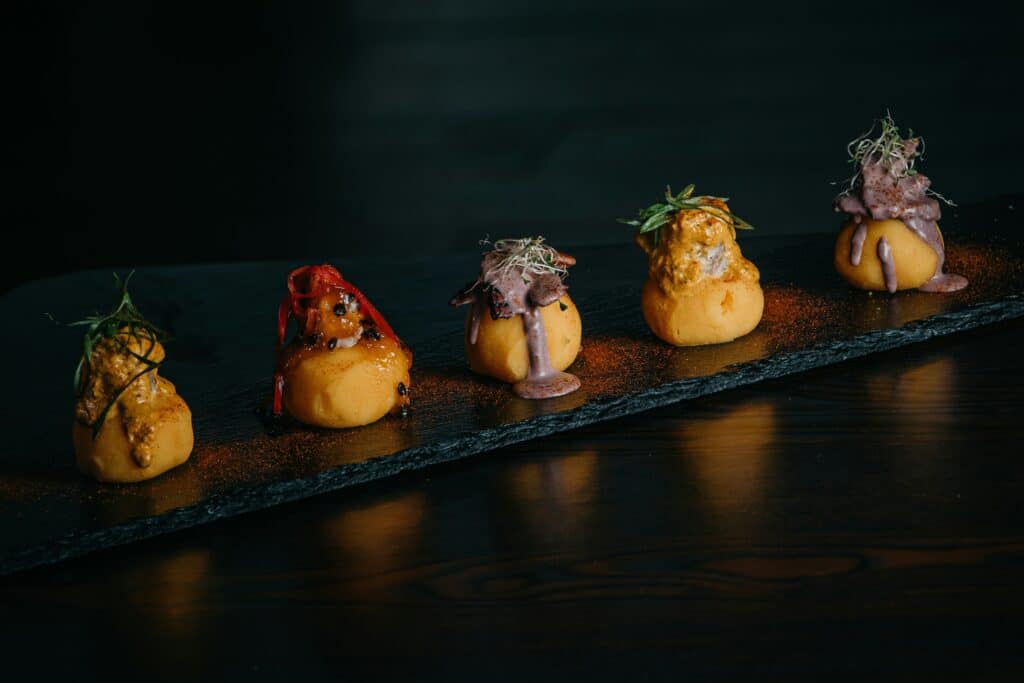
Potatoes are the center of attention again, in this dish of mashed potatoes (often yellow potatoes) mixed with ají amarillo, lime juice and seasoning. It’s generally thought that causa comes from the Quechua word kausay meaning “life.” Another theory is that it comes from the Spanish por la causa (“for the cause”) and refers to the food given to soldiers during Peru’s War of Independence.
Fillings vary, but shredded chicken, tuna, or avocado are common, usually mixed with mayonnaise. The different components are layered to create a colorful and visually appealing dish, and it’s often topped with hard-boiled egg. Different versions exist, such as causa limeña, which originated in Lima but has now become a more generic name for the dish.
Picarones
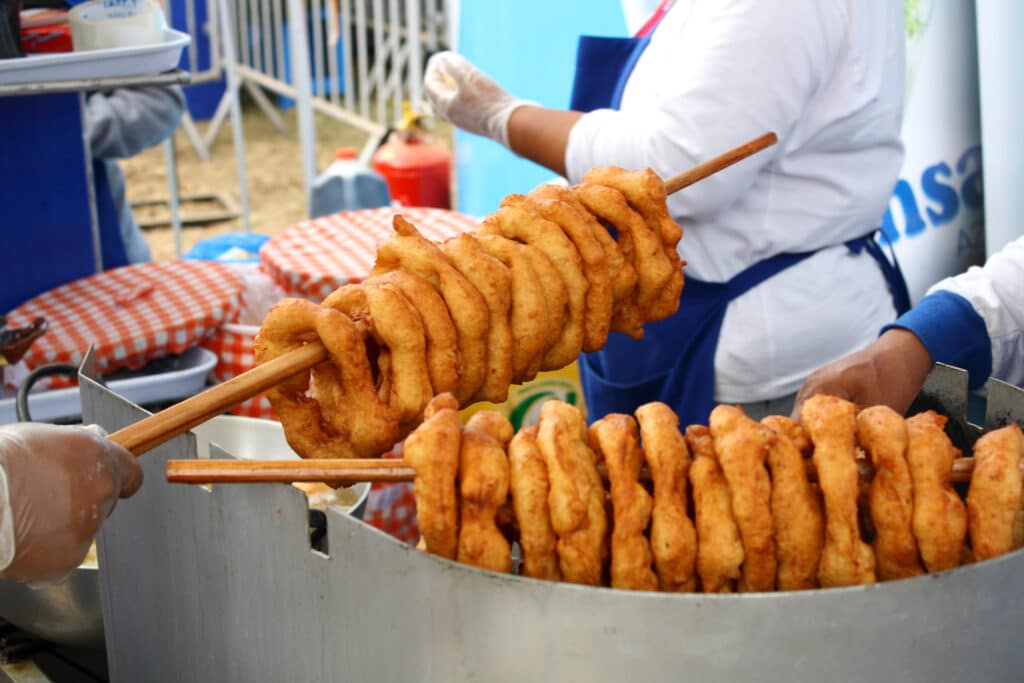
This street food is a must-try for anyone with a sweet tooth. The delicious fried treat, similar to a doughnut or fritter, is made from sweet potato or pumpkin. The name is rooted in Spanish and is thought to come from “picar” meaning (in this context) “to snack.” Picarones are served warm and often drizzled with chancaca, a syrup made from raw brown sugar, cinnamon, cloves and citrus peel.
Carapulcra
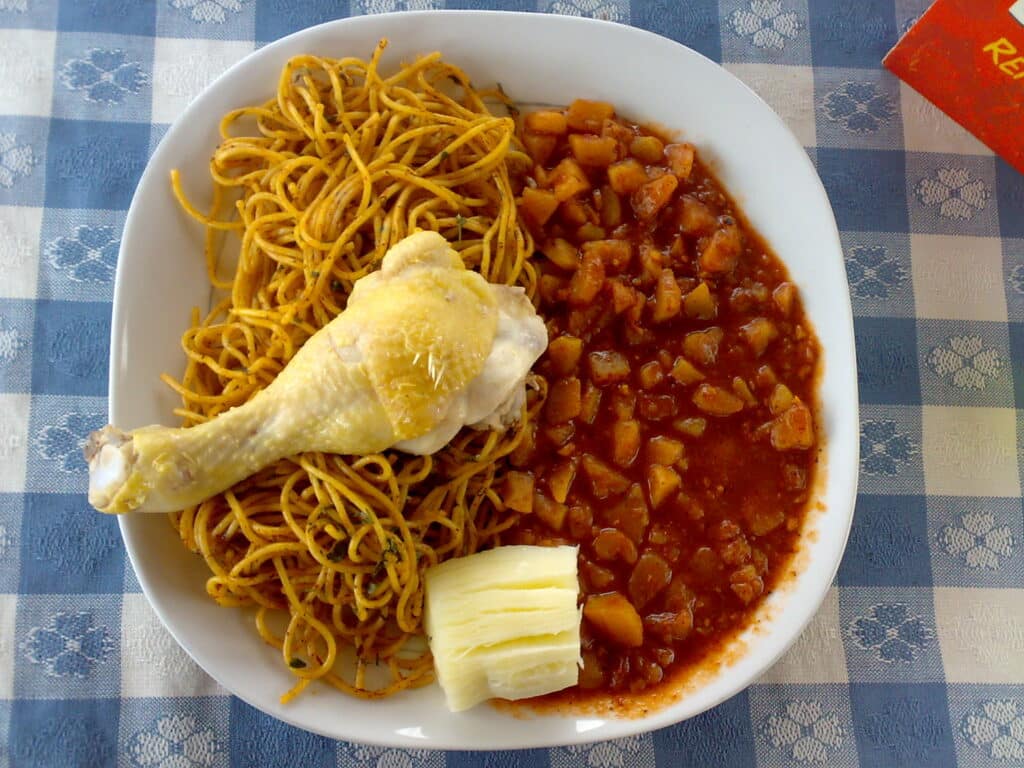
Carapulcra is an Andean dish that dates back hundreds of years. The Quechuan dish kalapurca, which is thought to be the dish’s earliest form, means “stew on hot stones,” a reference to the dish and how it was traditionally cooked.
Recipes vary, but key ingredients are meat (often pork), rehydrated dried potatoes and peanuts. The cooking broth contains a variety of other ingredients, such as ají panca, onions, tomatoes, garlic and cumin. It’s a rich and comforting dish that’s often prepared for special occasions.
Suspiro Limeño
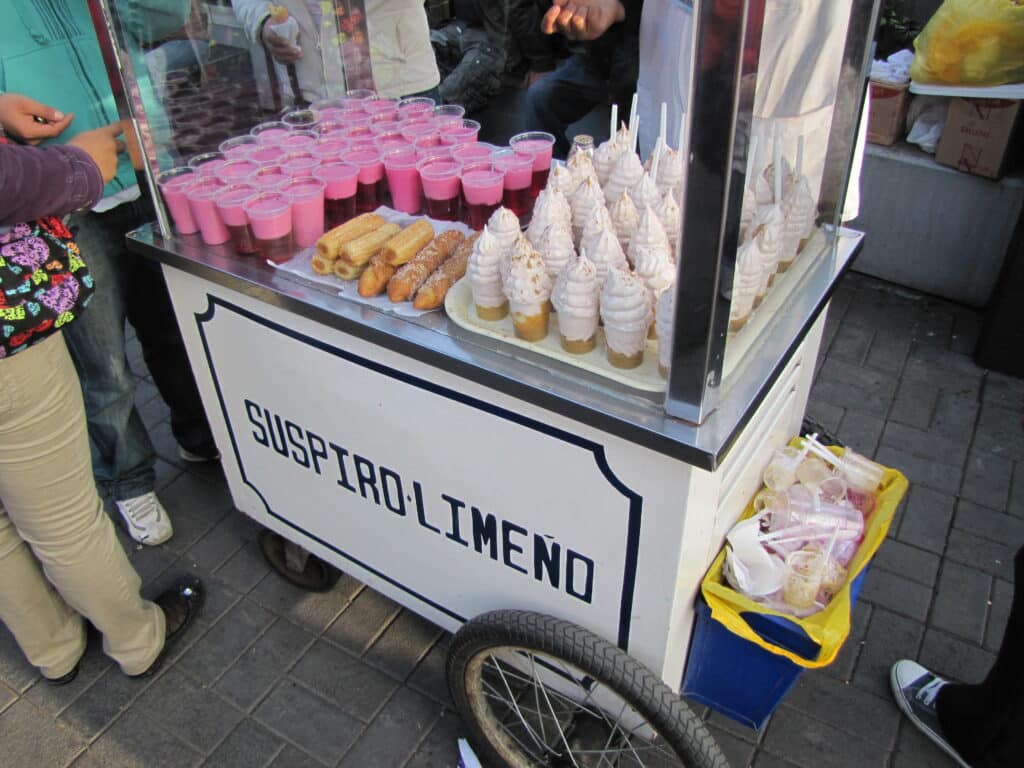
This Peruvian dessert’s name comes from the Spanish words suspiro, meaning “sigh,” and limeño, which is the name of a person from the country’s capital, Lima. The implication is that the dish is so delicious and indulgent that it makes you sigh with happiness.
The dessert consists of a base of dulce de leche (a sweet, milk-based caramel), egg yolks and milk topped with lightly-browned meringue. It’s served cold and is popular at celebrations and special occasions due to its rich and indulgent nature.
More Peruvian dishes you won’t want to miss:
Pollo a la brasa
The Peruvian roasted chicken, which is first marinated and then typically cooked on a rotisserie until the meat is juicy and the skin is crispy.
Chupe de Camarones
A rich shrimp chowder from the Arequipa region of peru. The shrimp heads and shells form the base of a flavorful broth, to which onions, garlic, ají amarillo paste, potatoes, corn and rice are added. Finally, shrimp, fava beans and evaporated milk go in.
Chicha Morada
A traditional non-alcoholic drink made from purple corn. The ingredients, which also include pineapple, apple, cinnamon, cloves, sugar and lime juice, are boiled in water and then strained. The drink is typically served cold and is prized for being rich in antioxidants.
Cau cau
A dish of tripe cooked with potatoes, ají amarillo and spices like turmeric and mint. The dish has Afro-Peruvian roots and is popular in Peruvian homes.
Arroz con pato
If you translate the name (“rice with duck”) from Spanish, the dish speaks for itself. Marinated duck joins a flavorful rice mixture that includes onions, garlic, ají amarillo, spices, vegetables, beer and plenty of cilantro. Arroz con pollo (rice with chicken) is another popular dish.
Pachamanca
Originating in and around Cusco in the Andean region, this dish’s name comes from the Quechua words pacha meaning “earth” and manca meaning “pot” and refers to the method of cooking the dish underground. Meat (traditionally lamb, chicken, pork, beef, alpaca or even guinea pig (“cuy”) is cooked with potatoes, corn, vegetables, herbs and spices to create a dish rich in cultural history and tradition.
Juane
This dish originates in the Peruvian Amazon and is typically eaten on June 24th during the San Juan Festival. It’s a mixture of meat (usually chicken), rice, herbs, spices and vegetables. Everything is wrapped in a banana leaf, then steamed or boiled.
Also don’t miss:
Seco de carne, rocoto relleno, tacu tacu and parihuela.
Exploring Peruvian cuisine in Miami
Globally, Miami has one of the biggest Peruvian expat communities, which increased significantly in the late 20th century and early 21st century. From high-end restaurants to local, family-run eateries, you can find authentic Peruvian food to suit any budget. There are also Peruvian supermarkets that sell a wide range of authentic Peruvian ingredients.
More about Peru
Peru is an incredibly diverse country with stunning landscapes, breathtaking mountains, dense rainforest, arid deserts, vibrant cities and much more. There’s something for everyone, so why not consider it as the destination for your next global adventure?
FAQs
There are many dishes in Peru that are a great source of pride for Peruvians and have a rich history. Some of the best-known dishes are ceviche, lomo saltado, causa rellena and, for beverages, the pisco sour.
Peruvian cuisine has a rich and diverse history. Some key ingredients that are indigenous to Peru are quinoa, potatoes and corn. Other staple foods include rice and certain types of meat.
Peruvian cuisine uses a wide range of ingredients. Some ingredients that are central to many dishes are potatoes, corn, onions, garlic, tomatoes, herbs, chili peppers, cumin, rice and quinoa.
There are a wide variety of products, including indigenous ingredients such as potatoes and corn. Meat is commonly used and there’s an abundance of fresh seafood, reflected in dishes such as ceviche and tiradito. Peruvian food has a variety of global influences, which has created a fusion of different flavors and techniques such as chifa (a Chinese influence) and nikkei (influences from Japanese cuisine).
Yes, Peruvian restaurants are common in many major cities around the world, particularly in North America and Europe. Cities like New York, Los Angeles, London and Madrid have a wide choice of Peruvian food. Read reviews and menus to find the most authentic options.
Peru is celebrated for its rich and diverse history and geography. The country is known for its cuisine and is also home to one of the world’s most-visited sites, Machu Picchu, an iconic example of Inca architecture.
How Does Peruvian Cuisine Reflect the Influences of Native American Tribes in its History and Culture?
Peruvian cuisine is a rich tapestry woven from diverse ingredients and techniques, deeply rooted in native american history. The use of indigenous crops like potatoes and corn showcases the profound influence of native cultures on culinary practices. This fusion creates dishes that celebrate Peru’s vibrant heritage and cultural identity.

